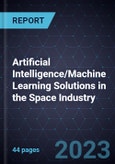Advanced Algorithms, Enhanced Satellite Operations, Autonomous Space Exploration, and Responsive Space Situational Awareness to Propel the Next generation Space Ecosystem
The integration of artificial intelligence (AI) and machine learning (ML) within the space industry has the potential to significantly enhance satellite operations, space exploration, and space situational awareness, among other areas. This report investigates the impact of AI/ML on various aspects of the space industry, including satellite network management, satellite health management, attitude and orbit control systems (AOCS), and space weather monitoring. Additionally, the report addresses AI/ML techniques and challenges associated with implementing AI/ML technologies onboard satellites, such as processing capabilities and environmental constraints.
As the space industry expands, particularly with the emergence of low-Earth orbit (LEO) satellite constellations, AI/ML technologies have become instrumental in managing complex satellite networks. By enabling efficient routing procedures that consider multiple attributes, AI/ML applications ensure high-quality service and low latency. Furthermore, the increased autonomy provided by AI/ML reduces the reliance on ground station availability, thus streamlining satellite network management and optimizing resource utilization.
AI/ML technologies also hold promise in the field of satellite health management by minimizing dependence on ground operators and providing more accurate fault predictions. The capacity to efficiently analyze extensive datasets and offer real-time fault predictions allows for the implementation of timely mitigation measures and the potential extension of satellite component lifecycles. Although still in the early stages of development, AI/ML technologies are poised to significantly improve the safety and success of space missions through enhanced satellite health management.
Lastly, AI/ML applications in AOCS and space weather monitoring offer substantial advantages over traditional methods. AI-based star identification enables robust, rapid, and precise attitude determination, while AI-enhanced space weather monitoring facilitates comprehensive data collection and expeditious information dissemination. As the space industry continues to evolve, AI/ML technologies are set to play an increasingly crucial role in addressing the growing complexities and challenges associated with space operations, exploration, and security.








